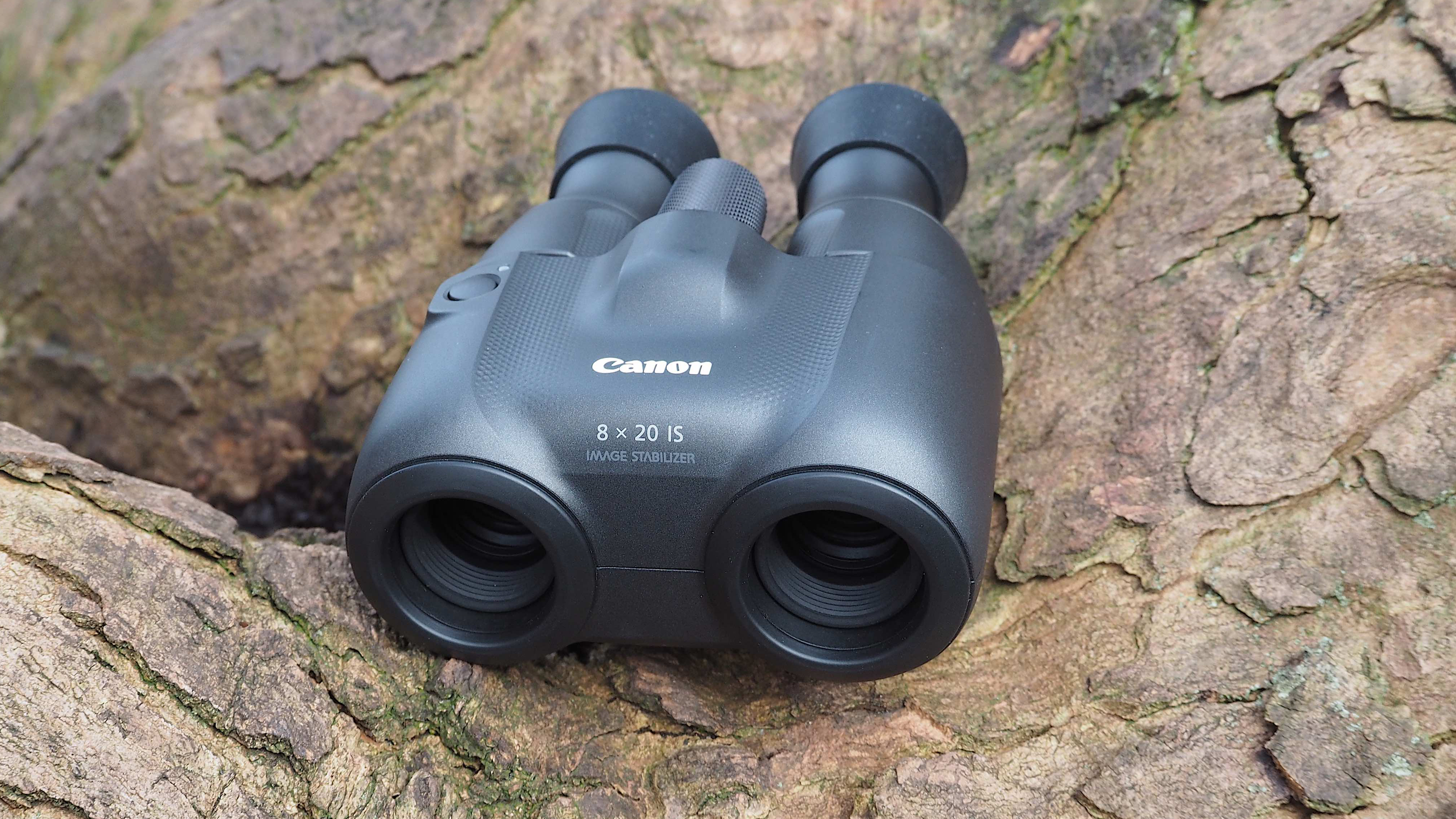
Although the technology is very much available, image stabilised, anti-shake binoculars remain a rare beast. That’s even when it’s widely acknowledged that viewing subjects at increased magnification can also magnify the effects of any slight wobble of the user’s hands. This results in subjects appearing to judder or ‘dance’ within our field of view.
While binoculars with battery and gyro sensor powered image stabilisation can counter balance external shake and deliver smooth results, meaning that formerly ‘dancing’ subjects now appear to merely glide as we pan from left to right, having this anti shake feature both increases overall bulk and, inevitably, price. So the question is, are image-stabilised binoculars actually worth it?
Enter the Canon 8x20 IS binocular, which we’re reviewing here. As with the slightly higher-powered 10x20 IS binocular in the same manufacturer’s range, this is a slightly futuristic, bulbous looking porro prism device with image stabilisation powered by lithium battery. And because it can help reduce judder, ‘IS’ can also reduce eye-strain when the binocular is in use for prolonged periods.
The alternative would be to mount our binocular on a tripod of course. Although there looks to be room here on the base to have included a screw thread for a tripod, Canon hasn’t bothered, perhaps reasonably thinking that with its body integral image stabilisation, any user won’t actually need one.
That’s the theory anyway. So how does use of the Canon 8x20 IS binocular pan out in practice?
Canon 8x20 IS Specifications
Canon 8x20 IS Key Features

While lens shift image stabilization is potentially a very useful feature, the core specification that accompanies it here is fairly modest when compared to standard non IS binoculars.
That ‘8x20’ denotes an entry-level class 8x magnification wedded to a small-ish 20mm objective lens. While that’s fine for casual or occasional use, anyone seeking to observe skittish wildlife or faraway subjects for prolonged periods or in failing light might be better served by something like a 10x magnification married to a 42mm objective lens for a bigger, brighter view, and even the ability to tripod mount the binocular for further comfort. Obviously that might necessitate a larger device, so such recommendations inevitably come with caveats and compromises.
The plus side to a modest 8x20 specification is that it helps maintain relatively compact proportions and the convenience of portability, despite the image stabilization feature adding bulk. A case of Canon playing safe perhaps, or at least attempting to deliver a product that is aesthetically pleasing and not chunkily off-putting. And after all, if we’ve a binocular we can fit in a jacket pocket, at a squeeze, we’re more likely to take it out with us and have it to hand when needed.

As it is, its manufacturer was claiming the 8x20 IS as the world’s lightest image stabilized binoculars upon launch back in 2019 at a weight of 420g excluding tiny battery, which may be reason enough to consider a purchase.
Here eye relief is a reasonable 13.5mm, rubber eyecups ensuring comfortable viewing whether wearing spectacles or not. Manual focus is achieved by rotating the large and obvious focus wheel located directly between the eyepieces; this control falls within easy reach of our forefinger as our eyes are glued to our subject. There are lugs beneath each eyepiece for attaching a neck or shoulder strap, as desired.
As with Canon’s 10x20 IS model, closest focusing distance is two metres, while this lesser magnification 8x20 IS binocular takes the same CR123A lithium battery to power its image stabilizer. Less easy to source in an emergency than AAA or AA batteries perhaps, but it all helps to keep the weight and build manageable. It also provides up to 12 hours of constant use.
Canon 8x20 IS Build & Handling

While there’s a subtly roughened, dimpled surface to the central area of this binocular, providing a less slippery surface for our fingertips when gripped, overall the smooth curves of the Canon 8x20 IS had us feeling there was the potential for it to slip from our grasp, although wearing gloves improved things in this regard.
As on the 10x20 IS model, ideally we’d have preferred a rubber armored coating that would provide both greater purchase for our fingers in both wet and dry, plus some extra protection were we to accidentally knock or drop this device.
The eyepieces of the 8x20 IS are protected by slip-on plastic caps. But, because these don’t feature a plastic loop or lug to attach them to a strap, they’re easy to mislay. As it is, they easily become detached in the process of retrieving the binocular from the soft carry case provided out of the box. Thus the protective caps feel like a bit of an afterthought rather than being fully integrated. There are no front lens caps at all, there being no way to practically attach them.
Surprisingly, and this is a bonus, the width between the eyepieces can be slightly adjusted to better suit the distance between our own eyes. Usually compact binoculars a have central folding mechanism to allow this to happen, meaning the whole body folds; however on this Canon, the eyepieces themselves marginally rotate between 56mm and 72mm, while the front half stays rigid and resolutely fixed.
As noted, the manual focus wheel is located equidistant between the eyepieces. A tactile and industrial looking roughened surface allows for precise, incremental adjustments to be made to arrive at critical focus, while our eyes are otherwise glued to the eyepieces. Overall, build quality is as robust as we’d expect from Canon, even if this particular model isn’t waterproof or even weather resistant.
Canon 8x20 IS Performance

What makes the Canon 8x20 IS different from the majority of binoculars is its image stabilization feature. So the question is, is it worth having and paying extra for over a more conventional non-IS binocular? One which, for example, might offer a bigger objective lens, increased magnification and possibly also a weather resistant or waterproofed build instead?
Here image stabilization is deployed with a press of its indented top plate button, a small LED indicator lamp glowing green as affirmation that the feature is active, if we weren't quite sure from viewing the scene with our own eyes.
Since Canon isn’t pushing the boat out here in terms of specification, it is perfectly possible to hold this compact binocular fairly steady even without ‘IS’, resting the eyecups against our eye sockets. That said, when we did press down and hold the dedicated button, we did notice any slight judder resulting from shaky hands had been ironed out, while the image before us still appeared perfectly natural.
Though it’s not immediately obvious just from using the device, as the green indicator isn’t easy to ‘read’ in sunlight, there are actually two ‘IS’ modes: Normal IS – whereby we need to keep our finger pressing down on the button for however long we need the feature – and Powered IS, which provides up to five minutes of continuous operation with a single press. This second option pertains to be better for when we ourselves are in motion and we need to compensate for potentially stronger image shake than would occur if standing still.
While, yes, to our eyes built-in image stabilization does indeed make a difference here, it’s not as pronounced a difference as it would be if we were using Canon’s 10x20 IS alternative, or even the physically longer, heavier yet altogether better specified Canon 12x36 IS III model we had in for review at the same time as this one. When it comes to the latter model, we believe the IS feature is more definitively worth having.
Its key selling point aside, the view through the 8x20 IS is already commendably sharp and clear, with good colour and minimal chromatic aberration visible, if at all.
Summing up, what we’re getting with the anti shake feature of the 8x20 IS binocular is a steadier view than we’d get without, and, once used, it’s a function that we’ll probably be returning to. That said, for regular daytime observation from a stock-still position, the improvement over a non IS image is a fairly subtle one.

Canon 8x20 IS Verdict
The Canon 8x20 IS shares the mantle of the world’s lightest binoculars to feature on-board image stabilisation with its 10x20 IS bigger brother. However, given the modest specification of this particular model means it can be used perfectly well without deploying ‘IS’, we feel its maker isn’t exactly pushing its tech to its limit here. Even if viewing with this feature activated is indeed a subtly smoother experience than without.
On the plus side, anyone seeking a binocular that manages to be at once portably compact while also featuring body integral anti shake and sharp and clear results with it, needs to look no further than this Canon 8x20 IS. Just expect to pay a sizeable premium over a non-image stabilized binocular… so be really sure you actually need that feature.







